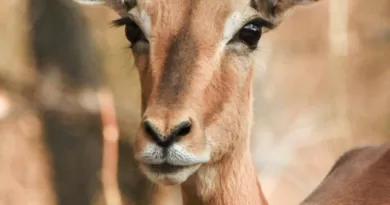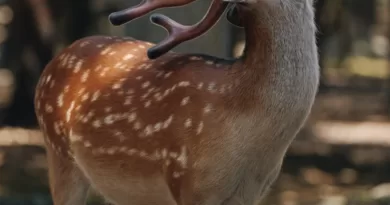How Should a Downed Deer Be Approached
Identifying Signs of a Downed Deer: Understanding the Behavior and Body Language
Recognizing signs of a downed deer requires a keen understanding of their behavior and body language. When injured or exhausted, deer tend to display certain telltale signs that can help us identify their condition. One common behavior is excessive panting, as injured deer may struggle to regulate their body temperature. They may also exhibit a lethargic or weak posture, with their head drooping low and ears hanging loosely. Another notable indication is a limping gait, often accompanied by favoring one leg over the other. By observing these behavioral cues, we can gain insight into the potential distress the deer is experiencing.
Furthermore, the body language of a downed deer can provide additional clues about their condition. A deer in pain may twitch or flinch noticeably when trying to move or when touched. Their eyes could appear dull or glazed, a sign of exhaustion or shock. Raised hackles along the back or a stiff tail can further suggest unease or discomfort. As empathetic observers, it is crucial to pay attention to these subtle cues in order to accurately assess the situation and provide appropriate assistance.
Ensuring Personal Safety: Precautions to Take Before Approaching a Downed Deer
Before approaching a downed deer, it is crucial to prioritize personal safety. Firstly, it is essential to ensure you are wearing appropriate protective gear, such as gloves and sturdy footwear. These items can offer some degree of protection in case the deer becomes aggressive or defensive. Additionally, it is advisable to keep a safe distance from the deer, as its injuries may cause it to act unpredictably. It is recommended to maintain a distance of at least 50 feet to avoid provoking any potential attacks.
Secondly, it is important to assess the surroundings for any potential hazards or obstacles that may impede movement or contribute to further injuries. Look out for broken branches, sharp objects, or steep terrain that could result in slips or falls. Clearing a path to ensure a quick retreat, if needed, is also crucial. Lastly, inform someone about your intentions before approaching the deer, preferably a friend or family member, so they can provide assistance or call for help if the situation escalates. By taking these precautions, you can minimize the risk of harm to yourself and maximize your ability to assist the injured deer effectively.
Assessing the Situation: Determining the Condition of the Deer and the Environment
The first step in assessing the situation is to carefully observe the deer and its surroundings. Take note of the deer’s posture, as it can provide valuable insights into its condition. A deer that is lying down and appears calm may only be resting, while one that is agitated or struggling to get up could be injured. Pay attention to any unusual behaviors, such as excessive panting or inability to move certain limbs, as these could indicate injuries.
Next, evaluate the environment to determine any potential hazards. Look for signs of nearby traffic or other elements that may pose a risk to your safety while approaching the deer. Additionally, consider the terrain and accessibility of the area, as this will affect your ability to provide assistance or transport the deer, if necessary. Remember, your safety should always be a priority when assessing the situation and deciding on the next steps to take.
Approaching Slowly and Quietly: Minimizing Stress and Agitation for the Injured Animal
One crucial aspect of approaching a downed deer is to do so slowly and quietly. By moving slowly, you can minimize any sudden movements or noises that may startle the injured animal. Quick or loud movements can cause the deer to become agitated and potentially worsen its condition. Approach the deer with measured steps and keep your movements deliberate and controlled.
Additionally, maintaining a quiet demeanor is essential for reducing stress and agitation in the injured animal. Deer have highly sensitive hearing and can easily be startled by loud noises. Ensure that you speak softly, if at all, when you approach the downed deer. This approach will help create a calm and peaceful environment for both you and the deer, allowing you to assess the situation more effectively and provide the necessary assistance while minimizing stress.
Maintaining a Safe Distance: Observing the Deer’s Behavior from Afar
Observing the deer’s behavior from a safe distance is crucial for both your safety and the well-being of the injured animal. Although your instinct may be to rush in and offer assistance, it is important to remember that a wounded deer can be unpredictable and may react aggressively when feeling threatened or cornered. By maintaining a safe distance, you allow the deer space and time to calm down and assess the situation.
Keep in mind that your presence alone can cause additional stress to the injured deer. The best approach is to observe the animal from afar, preferably behind cover or from a distance where you are not directly in its line of sight. Watch for any signs of distress or agitation, such as limping, excessive movement, or repetitive behaviors. These indications can help you determine the severity of the deer’s injuries and whether it requires professional assistance. By staying quiet and observing from a safe distance, you can gather important information about the deer’s condition before deciding on the next steps to take.
Assessing the Severity of Injuries: Identifying Potential Wounds or Broken Bones
Identifying the severity of injuries is crucial when dealing with a downed deer. While it may not always be obvious at first glance, there are signs that can help determine the potential wounds or broken bones that the animal may have sustained. Carefully observing the deer’s behavior and body language can provide valuable insights into its condition. Look for any visible wounds or bleeding, as well as any signs of limping or difficulty in movement. These could indicate fractures or other injuries that require immediate attention. It is important to approach the deer quietly and cautiously to avoid causing further distress or aggravating the injuries.
In addition to visual cues, it is vital to look for any abnormal positioning of the deer’s limbs or joints, as well as any signs of swelling or deformity. These could indicate potential fractures, dislocations, or sprains. Pay attention to the deer’s reactions when you get closer or attempt to touch it – signs of pain, flinching, or aggressive behavior may suggest localized injuries. However, it is important to keep in mind that assessing injuries without professional expertise can be challenging and potentially dangerous. If you suspect the deer has sustained serious injuries, it is best to reach out to the relevant authorities or wildlife organizations for assistance.
Seeking Professional Assistance: Contacting the Relevant Authorities or Wildlife Organizations
When confronted with a downed deer and unsure of how to proceed, it is essential to seek professional assistance by contacting the relevant authorities or wildlife organizations. These organizations have the knowledge and experience to handle such situations effectively. They are equipped to assess the condition of the deer, provide appropriate medical treatment if needed, and ensure the animal’s overall well-being.
One way to contact the relevant authorities or wildlife organizations is by calling the local animal control or wildlife rehabilitation center. They can provide guidance on the best course of action and may even dispatch a trained professional to assist with the situation. It is crucial to provide accurate and detailed information about the location, condition, and behavior of the deer when making the call. This will help them to assess the urgency of the situation and respond accordingly. Remember, seeking professional assistance is not only in the best interest of the deer but also ensures that you are acting in accordance with legal and ethical responsibilities.
Providing Basic First Aid: Simple Measures to Alleviate Pain or Discomfort
Once you have assessed the severity of the injuries and determined that it is safe to provide basic first aid, there are a few simple measures you can take to alleviate pain or discomfort for the downed deer. One of the most important things to remember is to approach the animal slowly and calmly, as sudden movements or loud noises can startle and agitate it further.
If you notice any obvious wounds, it is best to clean them gently with a sterile saline solution or clean water. Avoid using any harsh antiseptics or chemicals, as they may cause further irritation or harm to the deer. Applying a clean bandage or dressing to any bleeding wounds can help control the bleeding and provide some protection until professional help arrives. Remember to handle the deer with care and avoid putting excessive pressure on any injured areas.
These initial measures are meant to provide immediate relief and minimize the deer’s discomfort while awaiting professional assistance. It is crucial to remember that providing first aid should be done with caution and in compliance with ethical practices.
Transporting the Deer: Guidelines for Safely Moving the Animal, if Necessary
When it comes to transporting a downed deer, safety should always be the top priority. Moving an injured or incapacitated animal can be a delicate task that requires careful handling to avoid causing further harm. It is essential to approach the situation with caution and follow some guidelines to ensure the wellbeing of both the deer and the individuals involved.
One important aspect to consider is the use of proper equipment. When moving a deer, it is recommended to have a sturdy, non-slippery surface beneath the animal to provide stability and minimize the risk of injury. A T-shaped sled or a stretcher can be useful tools for transport, allowing for easier movement while ensuring that the deer’s body is adequately supported. Additionally, using gloves will not only protect your hands but also reduce the chances of transmitting any potential diseases to the animal or to yourself.
Ensuring Ethical Practices: Understanding Legal and Moral Responsibilities in Handling a Downed Deer
In handling a downed deer, it is imperative to understand and uphold legal and ethical responsibilities. The welfare of the animal should be a top priority, ensuring that it is treated with respect, dignity, and compassion. It is necessary to abide by local regulations and laws regarding the handling and transportation of injured wildlife.
Moreover, ethical considerations come into play when deciding the appropriate course of action. It is important to assess the severity of the deer’s injuries and its chances of recovery. In cases of severe injuries or when the animal’s suffering cannot be alleviated, it may be necessary to consider euthanasia as a humane option. However, it is essential to consult with the relevant authorities or wildlife organizations to seek professional advice and guidance in such situations. The ultimate goal should always be to act in the best interest of the deer, while respecting the legal and moral obligations associated with its handling.
• The welfare of the downed deer should be a top priority, ensuring it is treated with respect, dignity, and compassion.
• Abide by local regulations and laws regarding the handling and transportation of injured wildlife.
• Assess the severity of the deer’s injuries and its chances of recovery before making any decisions.
• Consult with relevant authorities or wildlife organizations for professional advice and guidance in severe cases or when euthanasia may be necessary as a humane option.
• Act in the best interest of the deer while respecting legal and moral obligations associated with its handling.
How can I identify if a deer is downed?
Look for signs of abnormal behavior or body language such as struggling to stand, dragging limbs, or appearing disoriented.
What precautions should I take before approaching a downed deer?
Ensure your own safety by wearing protective clothing, using gloves, and being aware of your surroundings.
How can I assess the condition of the deer and its environment?
Observe the deer’s breathing, movement, and responsiveness while also considering the presence of predators, traffic, or other potential dangers nearby.
How should I approach a downed deer?
Approach slowly and quietly to minimize stress and agitation for the injured animal.
Is it important to maintain a safe distance from the downed deer?
Yes, it is crucial to observe the deer’s behavior from afar to avoid further distressing or injuring the animal.
How can I identify potential wounds or broken bones on the downed deer?
Carefully examine the deer’s body for visible wounds, bleeding, or signs of fractures.
What should I do if I find a downed deer?
Contact the relevant authorities or wildlife organizations for professional assistance.
Should I provide first aid to the downed deer?
Basic first aid measures can be taken to alleviate pain or discomfort, but always seek professional advice if unsure.
How can I safely transport a downed deer, if necessary?
Follow guidelines provided by the relevant authorities or wildlife organizations to ensure safe transportation of the animal.
Why is it important to understand legal and moral responsibilities in handling a downed deer?
Understanding these responsibilities helps ensure ethical practices and promotes the well-being of the deer and the safety of individuals involved.




